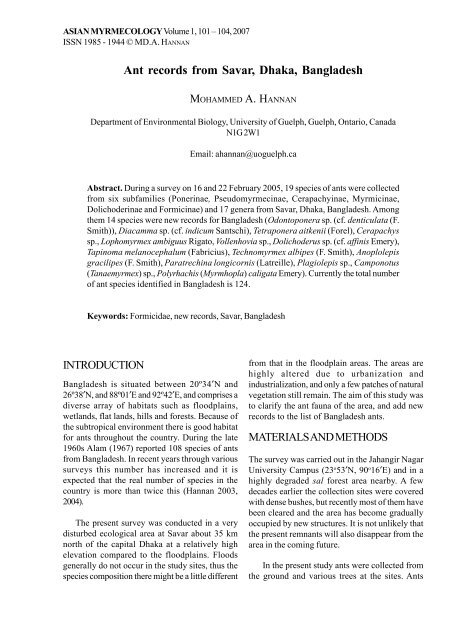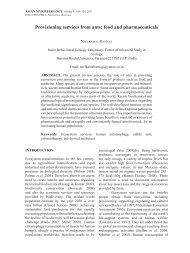Ant records from Savar, Dhaka, Bangladesh - Asian Myrmecology
Ant records from Savar, Dhaka, Bangladesh - Asian Myrmecology
Ant records from Savar, Dhaka, Bangladesh - Asian Myrmecology
Create successful ePaper yourself
Turn your PDF publications into a flip-book with our unique Google optimized e-Paper software.
ASIAN MYRMECOLOGY Volume 1, 101 – 104, 2007<br />
ISSN 1985 - 1944 © MD.A. HANNAN<br />
<strong>Ant</strong> <strong>records</strong> <strong>from</strong> <strong>Savar</strong>, <strong>Dhaka</strong>, <strong>Bangladesh</strong><br />
MOHAMMED A. HANNAN<br />
Department of Environmental Biology, University of Guelph, Guelph, Ontario, Canada<br />
N1G 2W1<br />
Email: ahannan@uoguelph.ca<br />
Abstract. During a survey on 16 and 22 February 2005, 19 species of ants were collected<br />
<strong>from</strong> six subfamilies (Ponerinae, Pseudomyrmecinae, Cerapachyinae, Myrmicinae,<br />
Dolichoderinae and Formicinae) and 17 genera <strong>from</strong> <strong>Savar</strong>, <strong>Dhaka</strong>, <strong>Bangladesh</strong>. Among<br />
them 14 species were new <strong>records</strong> for <strong>Bangladesh</strong> (Odontoponera sp. (cf. denticulata (F.<br />
Smith)), Diacamma sp. (cf. indicum Santschi), Tetraponera aitkenii (Forel), Cerapachys<br />
sp., Lophomyrmex ambiguus Rigato, Vollenhovia sp., Dolichoderus sp. (cf. affinis Emery),<br />
Tapinoma melanocephalum (Fabricius), Technomyrmex albipes (F. Smith), Anoplolepis<br />
gracilipes (F. Smith), Paratrechina longicornis (Latreille), Plagiolepis sp., Camponotus<br />
(Tanaemyrmex) sp., Polyrhachis (Myrmhopla) caligata Emery). Currently the total number<br />
of ant species identified in <strong>Bangladesh</strong> is 124.<br />
Keywords: Formicidae, new <strong>records</strong>, <strong>Savar</strong>, <strong>Bangladesh</strong><br />
INTRODUCTION<br />
<strong>Bangladesh</strong> is situated between 20º34′N and<br />
26º38′N, and 88º01′E and 92º42′E, and comprises a<br />
diverse array of habitats such as floodplains,<br />
wetlands, flat lands, hills and forests. Because of<br />
the subtropical environment there is good habitat<br />
for ants throughout the country. During the late<br />
1960s Alam (1967) reported 108 species of ants<br />
<strong>from</strong> <strong>Bangladesh</strong>. In recent years through various<br />
surveys this number has increased and it is<br />
expected that the real number of species in the<br />
country is more than twice this (Hannan 2003,<br />
2004).<br />
The present survey was conducted in a very<br />
disturbed ecological area at <strong>Savar</strong> about 35 km<br />
north of the capital <strong>Dhaka</strong> at a relatively high<br />
elevation compared to the floodplains. Floods<br />
generally do not occur in the study sites, thus the<br />
species composition there might be a little different<br />
<strong>from</strong> that in the floodplain areas. The areas are<br />
highly altered due to urbanization and<br />
industrialization, and only a few patches of natural<br />
vegetation still remain. The aim of this study was<br />
to clarify the ant fauna of the area, and add new<br />
<strong>records</strong> to the list of <strong>Bangladesh</strong> ants.<br />
MATERIALS AND METHODS<br />
The survey was carried out in the Jahangir Nagar<br />
University Campus (23 o 53′N, 90 o 16′E) and in a<br />
highly degraded sal forest area nearby. A few<br />
decades earlier the collection sites were covered<br />
with dense bushes, but recently most of them have<br />
been cleared and the area has become gradually<br />
occupied by new structures. It is not unlikely that<br />
the present remnants will also disappear <strong>from</strong> the<br />
area in the coming future.<br />
In the present study ants were collected <strong>from</strong><br />
the ground and various trees at the sites. <strong>Ant</strong>s
102 <strong>Ant</strong> <strong>records</strong> <strong>from</strong> <strong>Savar</strong>, <strong>Dhaka</strong>, <strong>Bangladesh</strong><br />
were more readily visible on trees than on the<br />
ground, but also collected <strong>from</strong> the ground when<br />
seen. No gyne or male was collected in the present<br />
study as no nest was dug to collect samples. The<br />
days (16 & 22 February 2005) of ant collection<br />
were sunny with very good weather. <strong>Ant</strong>s were<br />
collected between 10:00 and 15:00h using a sieve,<br />
tray and forceps and kept in small plastic vials<br />
containing 80% alcohol. They were cleaned and<br />
sorted to subfamily level in the laboratory, and<br />
then sent to taxonomic specialists for<br />
identification.<br />
RESULTS AND DISCUSSION<br />
The ant species (Formicidae) found during the<br />
survey are listed in Table 1. A total of 19 species<br />
were collected <strong>from</strong> the area in six subfamilies<br />
(Ponerinae, Pseudomyrmecinae, Cerapachyinae,<br />
Myrmicinae, Dolichoderinae and Formicinae) and<br />
17 genera. Fourteen species are new <strong>records</strong> for<br />
the country; an additional five are new <strong>records</strong> for<br />
the studied area, but known <strong>from</strong> other parts of<br />
the country (see Table 1) (cf. Bingham 1903; Alam<br />
1967; Ward 2001; Hannan 2003, 2004). Including<br />
the present <strong>records</strong> the current total number of<br />
ant species identified in <strong>Bangladesh</strong> is 124. As<br />
mentioned this survey is a part of a continued<br />
effort that will collect <strong>from</strong> all habitats of the<br />
country; therefore a comprehensive inventory of<br />
the ants of <strong>Bangladesh</strong> is ultimately envisaged.<br />
Odontoponera sp. (cf. denticulata (F. Smith)) 1<br />
is a new record in <strong>Bangladesh</strong>, but is widespread<br />
in the Oriental region, especially in disturbed areas.<br />
Diacamma sp. (cf. indicum Santschi) is new to<br />
<strong>Bangladesh</strong>. Tetraponera allaborans (Walker) is<br />
found throughout <strong>Bangladesh</strong> (Alam 1967). The<br />
species is widespread in tropical Asia and Australia<br />
(Bingham 1903; Ward 2001). T. rufonigra (Jerdon)<br />
is a congener recorded <strong>from</strong> various parts of the<br />
country (Ward 2001; Hannan 2004) but not found<br />
1 Editors’ note: this species was synonymised with O.<br />
transversa (F. Smith) (Dalla Torre CG de 1893. Catalogus<br />
Hymenopterorum, hucusque descriptorum systematicus<br />
et synonymicus 7: 30.) but is considered distinct by Seiki<br />
Yamane (unpublished).<br />
in the studied area. Tetraponera aitkenii (Forel)<br />
is new to <strong>Bangladesh</strong>. This species is known <strong>from</strong><br />
southern India, and once in Malaysia (Ward 2001).<br />
Cerapachys sp. is a new record for the country;<br />
other species of the genus are found in Myanmar<br />
and India (Bingham 1903). Lophomyrmex<br />
ambiguus Rigato is new to <strong>Bangladesh</strong>. This<br />
species was also recorded <strong>from</strong> northern India and<br />
Nepal (Rigato 1994). Monomorium pharaonis<br />
(Linnaeus) is a tramp species found all over<br />
<strong>Bangladesh</strong> (Alam 1967). Bingham (1903) noted<br />
the species is widespread throughout the tropical<br />
regions of both hemispheres. Pheidologeton<br />
diversus (Jerdon) is common all over <strong>Bangladesh</strong><br />
and also in India (Alam 1967, Bolton 1995).<br />
Vollenhovia sp. is a new record for the country.<br />
Species of the genus are found in the Old-World<br />
tropics except for Africa (Bolton 1995).<br />
Dolichoderus sp. (cf. affinis Emery) is a new record<br />
for the country and also found in Myanmar (Bolton<br />
1995). Tapinoma melanocephalum (Fabricius) is a<br />
new record for <strong>Bangladesh</strong>. The species is<br />
widespread in tropical and subtropical regions of<br />
the world (Bingham 1903). Technomyrmex albipes<br />
(F. Smith) is new to the area, and possibly to<br />
<strong>Bangladesh</strong>. The species is found widely in<br />
tropical Asia.<br />
Oecophylla smaragdina (Fabricius) was<br />
recorded in <strong>Bangladesh</strong> <strong>from</strong> Karamjal,<br />
Sundarbans, and Khulna (Hannan 2004). This<br />
species is widely distributed in India, Myanmar<br />
and Sri Lanka. The range of this species extends<br />
through the Malayan subregion to Australia and<br />
New Guinea (Bingham 1903). Anoplolepis<br />
gracilipes (F. Smith) is a pantropical species, which<br />
is recorded for the first time in the study site and<br />
also in <strong>Bangladesh</strong>. Paratrechina longicornis<br />
(Latreille) is another pantropical species that has<br />
not been recorded <strong>from</strong> <strong>Bangladesh</strong> before the<br />
present study. Plagiolepis sp. was collected <strong>from</strong><br />
a tree. Plagiolepis dichroa Forel is common<br />
throughout <strong>Bangladesh</strong> (Alam 1967), but it is not<br />
certain that the present record is of this species.<br />
Foragers of Camponotus rufoglaucus (Jerdon)<br />
were also recorded before <strong>from</strong> Sylhet (Alam 1967).<br />
This species is found in various parts of India and<br />
Myanmar (Bingham 1903). The species has a very
MD. A. Hannan<br />
103<br />
Table 1: <strong>Ant</strong> species (Formicidae) collected <strong>from</strong> the study sites at <strong>Savar</strong>, <strong>Bangladesh</strong> in 2005.<br />
Species<br />
Stratum<br />
collected<br />
Collection<br />
record 1<br />
Ponerinae<br />
Odontoponera sp. (cf. denticulata (F. Smith, Jackfruit tree<br />
N<br />
1858))<br />
Diacamma sp. (cf. indicum (Santschi, 1920)) Jackfruit tree N<br />
Pseudomyrmecinae<br />
Tetraponera allaborans (Walker, 1859) Mango trees W<br />
Tetraponera aitkenii (Forel, 1902) Mango trees N<br />
Cerapachyinae<br />
Cerapachys sp. ground N<br />
Myrmicinae<br />
Lophomyrmex ambiguus Rigato, 1994 ground N<br />
Monomorium pharaonis (Linnaeus, 1758) ground W<br />
Pheidologeton diversus (Jerdon, 1851) ground W<br />
Vollenhovia sp. tree 2 N<br />
Dolichoderinae<br />
Dolichoderus sp. (cf. affinis Emery, 1889) tree 2 N<br />
Tapinoma melanocephalum (Fabricius, 1793) ground N<br />
Technomyrmex albipes (F. Smith, 1861) ground N<br />
Formicinae<br />
Oecophyla smaragdina (Fabricius, 1775) Jackfruit tree W<br />
Anoplolepis gracilipes (F. Smith, 1857) ground N<br />
Paratrechina longicornis (Latreille, 1802) ground N<br />
Plagiolepis sp. tree 2 N<br />
Camponotus rufoglaucus (Jerdon, 1851) Ficus tree W<br />
Camponotus (Tanaemyrmex) sp. Ficus tree N<br />
Polyrhachis (Myrmhopla) caligata Emery, 1895 Ficus tree N<br />
1<br />
N=new to the area and to <strong>Bangladesh</strong>; W=new to the study area but recorded elsewhere in <strong>Bangladesh</strong>.<br />
2<br />
Unidentified tree species.
104 <strong>Ant</strong> <strong>records</strong> <strong>from</strong> <strong>Savar</strong>, <strong>Dhaka</strong>, <strong>Bangladesh</strong><br />
wide range of occurrence <strong>from</strong> Australia to Africa.<br />
Camponotus (Tanaemyrmex) sp. foragers were<br />
collected <strong>from</strong> a Ficus tree. This may be the first<br />
record of a Tanaemyrmex species <strong>from</strong><br />
<strong>Bangladesh</strong>. Polyrhachis (Myrmhopla) caligata<br />
Emery is new to <strong>Bangladesh</strong>.<br />
Some of the species that were collected in the<br />
disturbed areas are tramp or pantropical species,<br />
which implies the survey site was severely altered<br />
by human activities, even though some patchy<br />
vegetation (shrubland and sparse forest) still<br />
remained. The literature on the ant fauna in<br />
<strong>Bangladesh</strong> is scarce. However, it is important to<br />
compile an accurate list of the ants of <strong>Bangladesh</strong><br />
based on new collections <strong>from</strong> throughout the<br />
whole country. This paper constitutes a step to<br />
such a goal.<br />
ACKNOWLEDGEMENTS<br />
The author is grateful to Professor Seiki Yamane<br />
(Department of Earth and Environmental Sciences,<br />
Faculty of Science, Kagoshima University, Japan)<br />
for identifying the ants and encouragement for<br />
continuing this research work. The comments of<br />
two anonymous reviewers are acknowledged<br />
thankfully that helped to improve the manuscript.<br />
He is also indebted to the Jahangir Nagar<br />
University authority as he has collected ants <strong>from</strong><br />
the campus for the study.<br />
REFERENCES<br />
Alam MZ, 1967. A Report on the Survey of Insect and<br />
Mite Fauna of <strong>Bangladesh</strong> (East Pakistan).<br />
<strong>Bangladesh</strong> (East Pakistan) Agricultural Research<br />
Institute, 151pp.<br />
Bingham CT, 1903. The Fauna of British India Including<br />
Ceylon and Burma. Hymenoptera-Vol.II., <strong>Ant</strong>s and<br />
Cuckoo-Wasps. Taylor and Francis, London, 506<br />
pp.<br />
Bolton B, 1995. A New General Catalogue of the <strong>Ant</strong>s<br />
of the World. Harvard University Press, Cambridge,<br />
504 pp.<br />
Hannan MA, 2003. <strong>Ant</strong>s of <strong>Bangladesh</strong>. ANeT<br />
Newsletter 6:10-14.<br />
Hannan MA, 2004. Addition of two species to the list<br />
of <strong>Bangladesh</strong> ants. ANeT Newsletter 6:13-14.<br />
Rigato F, 1994. Revision of the myrmicine ant genus<br />
Lophomyrmex, with a review of its taxonomic<br />
position (Hymenoptera: Formicidae). Systematic<br />
Entomology 19: 47-60.<br />
Ward PS, 2001. Taxonomy, phylogeny and biogeography<br />
of the ant genus Tetraponera (Hymenoptera:<br />
Formicidae) in the Oriental and Australian regions.<br />
Invertebrate Taxonomy 15: 589-665.<br />
Received: 20 November 2006; accepted: 19 February<br />
2007; published: August 2007<br />
ASIAN MYRMECOLOGY<br />
Published by the Institute for Tropical Biology & Conservation, Universiti Malaysia Sabah, Malaysia<br />
on behalf of ANeT — the International Network for the Study of <strong>Asian</strong> <strong>Ant</strong>s






